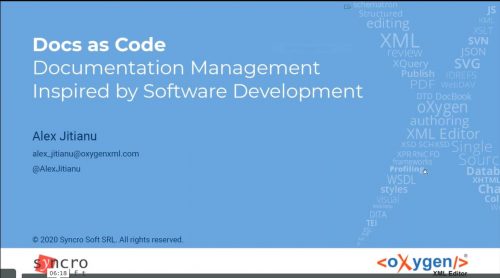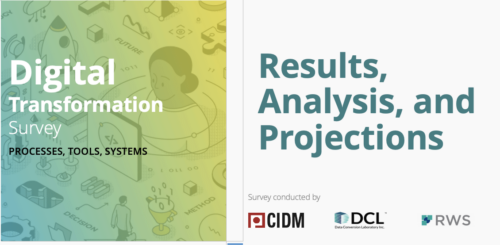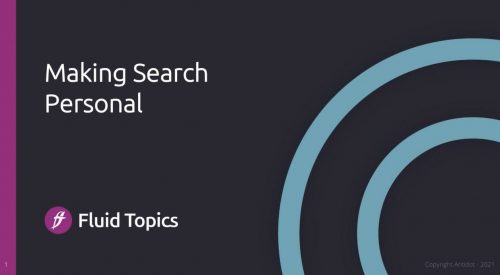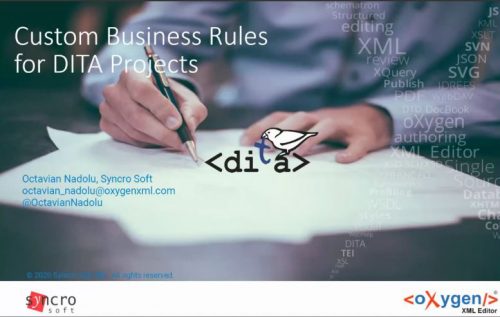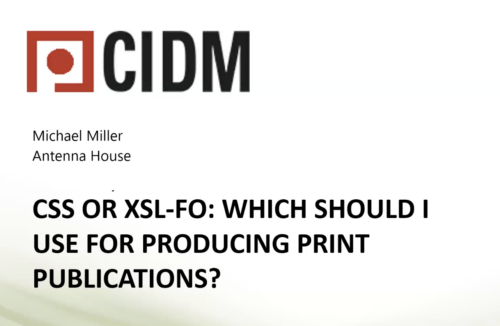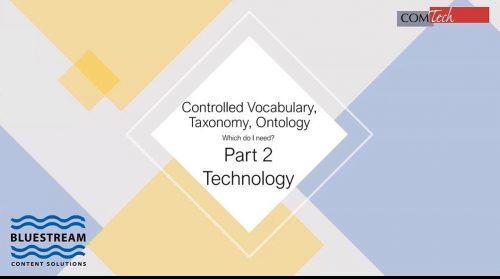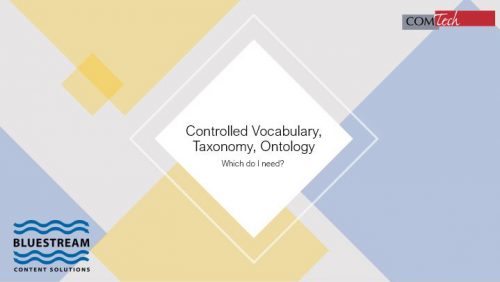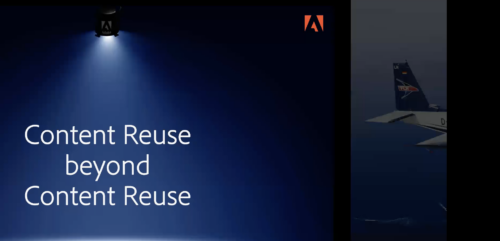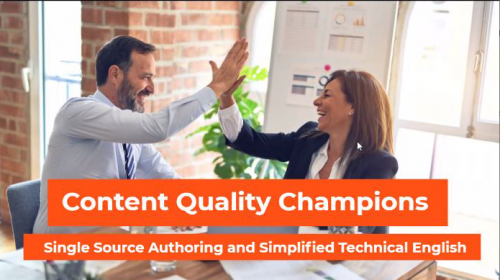- Storage and issue management using GitHub
- Automated quality checks and continuous publishing using Netlify
- Editing and collaboration support
- Release strategies
-
September 16, 2020 Tools and techniques used in software development can also be applied for documentation management:
-
Recorded on: March 27, 2024

DITA is a fantastic tool for authoring efficiency and content management. It might as well be the keystone for outstanding content experiences, like content personalization and multi-channel delivery. But caution! What was thought for content creation is not always the right fit for modern content publishing.
Drawing from his experience as a content expert and senior consultant at Fluid Topics, Gaspard Bébié-Valérian will address in this webinar the specifics for content delivery of two key elements, metadata and granularity, and how to enrich and optimize them to build exceptional experiences with your DITA content.
Don’t miss the opportunity to delve into practical use cases encountered during real-life implementations and gain insights to enrich your own content strategy."
Presented by Gaspard Bébié-Valérian At the crossroads of engineering and social sciences, Gaspard enjoys exploring the breadth of technologies involved in technical documentation, including structured documentation, CCMS, and DITA-OT. Gaspard works as content expert and senior consultant at Fluid Topics, helping clients get the most out of their Content Delivery Platform.
At the crossroads of engineering and social sciences, Gaspard enjoys exploring the breadth of technologies involved in technical documentation, including structured documentation, CCMS, and DITA-OT. Gaspard works as content expert and senior consultant at Fluid Topics, helping clients get the most out of their Content Delivery Platform. -
Recorded: August 25, 2022


 Digital Transformation is often defined as the process of using digital technologies to create or optimize business processes to improve company and customer experience and meet changing customer demand and market requirements.
Digital transformation may involve spending thousands, hundreds of thousands, or even millions of dollars purchasing new tools and technologies. No matter how many new tools and systems and how much money you put toward transforming your organization, a large piece of the digital transformation puzzle comprises a content transformation.
CIDM, DCL, and RWS wanted to understand what steps people are taking toward “digital transformation” and where content structure and information architecture fit into the plan. The three organizations launched a three-month long “Digital Transformation Survey” to understand how various industries address the adoption of processes, technology, tools, and information architecture.
The results have been collected, analyzed, and discussed. Now it’s time to share the results and our observations with you. No matter what industry you work in, digital transformation is happening on many levels, and understanding how your peers are applying resources, budget, and strategies can contribute to your success.
Presented by:
Digital Transformation is often defined as the process of using digital technologies to create or optimize business processes to improve company and customer experience and meet changing customer demand and market requirements.
Digital transformation may involve spending thousands, hundreds of thousands, or even millions of dollars purchasing new tools and technologies. No matter how many new tools and systems and how much money you put toward transforming your organization, a large piece of the digital transformation puzzle comprises a content transformation.
CIDM, DCL, and RWS wanted to understand what steps people are taking toward “digital transformation” and where content structure and information architecture fit into the plan. The three organizations launched a three-month long “Digital Transformation Survey” to understand how various industries address the adoption of processes, technology, tools, and information architecture.
The results have been collected, analyzed, and discussed. Now it’s time to share the results and our observations with you. No matter what industry you work in, digital transformation is happening on many levels, and understanding how your peers are applying resources, budget, and strategies can contribute to your success.
Presented by:
 Dawn Stevens, President, Comtech Services and Director of CIDM has 28 years of practical experience in virtually every role within a documentation and training department, including project management, instructional design, writing, editing, and multimedia programming. Dawn is the perfect advisor to identify and remove the challenges you face in producing usable, technical information and training content. With both engineering and technical communication degrees, Dawn combines her solid technical foundation with strong writing and design skills to lead our team of consultants and specialists in providing the expertise you need.
Dawn Stevens, President, Comtech Services and Director of CIDM has 28 years of practical experience in virtually every role within a documentation and training department, including project management, instructional design, writing, editing, and multimedia programming. Dawn is the perfect advisor to identify and remove the challenges you face in producing usable, technical information and training content. With both engineering and technical communication degrees, Dawn combines her solid technical foundation with strong writing and design skills to lead our team of consultants and specialists in providing the expertise you need.
 Mark Gross, President, Data Conversion Laboratory, is a recognized authority on XML implementation and document conversion. Mark also serves as Project Executive, with overall responsibility for resource management and planning. Prior to joining DCL in 1981, Mark was with the consulting practice of Arthur Young & Co. Mark has a BS in Engineering from Columbia University and an MBA from New York University. He has also taught at the New York University Graduate School of Business, the New School, and Pace University. He is a frequent speaker on the topic of automated conversions to XML and SGML.
Mark Gross, President, Data Conversion Laboratory, is a recognized authority on XML implementation and document conversion. Mark also serves as Project Executive, with overall responsibility for resource management and planning. Prior to joining DCL in 1981, Mark was with the consulting practice of Arthur Young & Co. Mark has a BS in Engineering from Columbia University and an MBA from New York University. He has also taught at the New York University Graduate School of Business, the New School, and Pace University. He is a frequent speaker on the topic of automated conversions to XML and SGML.
 Chip Gettinger is the VP of Global Solutions Consulting at RWS, he manages a team that works with customers in maximizing global content with RWS. He has experience working with customers to develop global content strategies, business ROI adoption drivers, change management, and technology adoption for component content management systems. He speaks and blogs about customer successes working closely with industry standards, partners, and customers in technology solutions and deployments.
Chip Gettinger is the VP of Global Solutions Consulting at RWS, he manages a team that works with customers in maximizing global content with RWS. He has experience working with customers to develop global content strategies, business ROI adoption drivers, change management, and technology adoption for component content management systems. He speaks and blogs about customer successes working closely with industry standards, partners, and customers in technology solutions and deployments. -
May 26, 2021 What if the search function on your tech doc was providing personalized results and was as good as Google, reading the mind of your users and anticipating their needs? What about a search engine that learns and gets more accurate, more relevant and personal every day. What does it take to get there? It’s mostly about technology, but not only. It also requires information: about your content (metadata) and about your users (profiles). In this Webinar, we will introduce the challenges, review the possible solutions, and discuss what you need to have and do in order to support this shift to a modern user experience. Presented by: Fabrice Lacroix is a serial entrepreneur and a technology pioneer. He has been working for 25 years on the development of innovative solutions around search technology, content enrichment and AI. He is the founder of Fluid Topics, the leading Content Delivery Platform that reinvents how users search, read and interact with technical documentation.
-
Recorded on: February 8, 2024
 Presented by: André Schlotz, RWS; Hareesh K, Sandvik Mining and Construction GmbH; and Harald Stadlbauer, MD, NINEFEBLearn how Sandvik Mining and Construction makes their DITA-based technical content fit to support their global servitization strategy. For many years Sandvik is creating, managing, translating, and publishing conditionalized DITA content with RWS technology and services. This content has been created with a “Safety First” approach and published as PDFs. Sandvik`s new digital service offerings – enabled through connected products - require customers and service technicians to retrieve personalized and relevant information components through their Web-based aftersales application My Sandvik / SmartMate with the new paradigm: provide the right information, for the right use case at the right time. To enable this a semantic data layer has been implemented combining existing taxonomies, product-structures and iiRDS. DITA topics are now tagged by taking advantage of the Semantic AI capabilities – so called “Smart Tagging”. The hereby created smart content components are then delivered and exposed in a content-as-a-service approach.
Presented by: André Schlotz, RWS; Hareesh K, Sandvik Mining and Construction GmbH; and Harald Stadlbauer, MD, NINEFEBLearn how Sandvik Mining and Construction makes their DITA-based technical content fit to support their global servitization strategy. For many years Sandvik is creating, managing, translating, and publishing conditionalized DITA content with RWS technology and services. This content has been created with a “Safety First” approach and published as PDFs. Sandvik`s new digital service offerings – enabled through connected products - require customers and service technicians to retrieve personalized and relevant information components through their Web-based aftersales application My Sandvik / SmartMate with the new paradigm: provide the right information, for the right use case at the right time. To enable this a semantic data layer has been implemented combining existing taxonomies, product-structures and iiRDS. DITA topics are now tagged by taking advantage of the Semantic AI capabilities – so called “Smart Tagging”. The hereby created smart content components are then delivered and exposed in a content-as-a-service approach.
André Schlotz is VP Global Automotive and Manufacturing Solutions, RWS Group. He helps organizations to digitalize their content supply chain through structured content authoring, component content management and single source content delivery. Before joining RWS in 2013 he was holding various management positions in manufacturing companies in product development, aftersales, process organization and IT. He has more than 20 years of experiences in process consulting, planning, building and running digital industry solutions.
 Hareesh Kanakaswamy is the Portfolio Manager of Digital Services Solutions at Sandvik Mining and Construction G.m.b.H. With 14+ years of experience in product development and aftermarket operations, he specializes in constructing end-to-end digital ecosystems for servitization strategies. Hareesh is a firm believer in innovation as the key to sustainable progress for humanity.
Hareesh Kanakaswamy is the Portfolio Manager of Digital Services Solutions at Sandvik Mining and Construction G.m.b.H. With 14+ years of experience in product development and aftermarket operations, he specializes in constructing end-to-end digital ecosystems for servitization strategies. Hareesh is a firm believer in innovation as the key to sustainable progress for humanity.
 Harald Stadlbauer, MD is General Manager of the NINEFEB Group of companies, dedicated to the advancement of Technical Communication, like Technical Documentation as well as eLearning to the intelligent delivery of it. He is actively engaged in developing iiRDS further as well as contributing to the AAS (Asset Administration Shell) sub-models of the IDTA (Industrial Digital Twin Association)
Harald Stadlbauer, MD is General Manager of the NINEFEB Group of companies, dedicated to the advancement of Technical Communication, like Technical Documentation as well as eLearning to the intelligent delivery of it. He is actively engaged in developing iiRDS further as well as contributing to the AAS (Asset Administration Shell) sub-models of the IDTA (Industrial Digital Twin Association)
-
December 16, 2020 A step by step guide to getting started with Schematron and Schematron Quick Fixes. Schematron and Schematron QuickFix (SQF) languages can be used to improve efficiency and quality when editing DITA documents. You can define actions that will add complex structure in your documents, or make modifications in multiple places or actions that will convert a structure into another. These changes are made by keeping the document structure valid and conforming to your project specification and will help the content writer add content more easily and without making mistakes. Join us to see:
- How to create business rules with Schematron
- How Schematron rules are applied
- How to apply specific Schematron rules on all DITA files
- How to develop Schematron Quick Fixes to make it very easy to solve the reported problems
-
Recorded on June 8, 2023

In this webinar, you will learn about the two recognized international standards available to address the fully automated formatting of pages and publications for PDF and print: CSS and XSL-FO. We will explore the two standards and address:
- When you should use automated document formatting versus desktop publishing
- The motivations for and benefits of automated document formatting
- The challenges
- Where CSS and XSL-FO fit within solutions for the overall delivery of formatted pages and publications

Michael Miller is Vice President of Antenna House, Inc., a company that has developed one of the leading standards‐based (XSL‐FO and CSS) document formatting software products on the market today. Michael has a degree in Printing Engineering and Management and has been involved in high‐end composition, document formatting, and document management for over 40 years. He has an extensive background with structured data, including SGML, XML, S1000D, and DITA. During his career, he has worked in Europe and North America and has been involved in the implementations of some of the largest fully automated publishing and document formatting projects.
-
August 10, 2020 Content developers and managers worldwide are coming together to share ideas and inspire each other at ConVEx in September. When first announced, we said ConVEx is not an online simulation of an in-person conference, but an immersive experience designed from the ground up to use our e-resources in the best possible way to bring you a wealth of ideas and information to support your efforts in defining and executing a comprehensive content strategy. During this Webinar, Dawn Stevens explains what we mean by this statement and what you can expect and gain from this new event format. We'll discuss the event format, the technology we'll use, and highlight the many networking activities provided. By the end of the Webinar, you'll know why you should attend ConVEx — it's an opportunity to have a positive experience, converge with others in the industry, focus your attention on industry issues, and magnify your value to your organization. Presented by: Dawn Stevens, President, Comtech Services and Director of CIDM has 28 years of practical experience in virtually every role within a documentation and training department, including project management, instructional design, writing, editing, and multimedia programming. Dawn is the perfect advisor to identify and remove the challenges you face in producing usable, technical information and training content. With both engineering and technical communication degrees, Dawn combines her solid technical foundation with strong writing and design skills to lead our team of consultants and specialists in providing the expertise you need.
-
April 6, 2021 Ironically, the terms used to describe a vocabulary of words that organize and catalog information within a content corpus are often used inconsistently or interchangeably. However, each term represents a point on an increasing scale of complexity and resulting data richness and applicability. Following Part 1 of this webinar in which Dawn Stevens of Comtech Services defined and compared these points along the taxonomy spectrum (view part 1 recording), Rik Page of Bluestream now demonstrates the technology and tools that enable you to define and manage your terms and relationships, as well as those that consume what you have defined. Participants will see practical, real-life applications of the taxonomical concepts previously presented. Click here to download the reading list referenced during this webinar. Presented by: Dawn Stevens is the President, and owner of Comtech Services and the Director of the Center for Information-Development Management. With over 25 years of experience, including 20 years at Comtech, Dawn has practical experience in virtually every role within a documentation and training department, including project management, instructional design, writing, editing, and multimedia programming. With both engineering and technical communication degrees, Dawn combines a solid technical foundation with strong writing and design skills to identify and remove the challenges her clients face in producing usable, technical information and training. Rik Page is Sales and Marketing Director at Bluestream Software and has been working with both component content and document management solutions since 2001. During this time, he has worked with custom DTDs and Schemas, S1000D, iSpec2200 and since 2005 DITA. His practical experience ranges from data capture/content creation through to dynamic multichannel delivery, achieved in a wide range of industries including banking and finance, manufacturing, central government and education. A keen advocate of technology and innovation Rik has taken part in multiple consultancy projects and helped formulate solutions all over the world. Away from the office Rik is a Scout Leader working with young people and helping them to develop new skills whilst having fun.
-
March 9, 2021 Ironically, the terms utilized to describe a vocabulary of words used to organize and catalog information within a content corpus often are used inconsistently or interchangeably. However, each term represents a point, on an increasing scale of complexity and resulting data richness and applicability. In this two-part webinar, Dawn Stevens of Comtech Services defines key points along this scale, comparing and contrasting the scope and domain to which each term applies, suggesting when each might be used, and recommending the processes for creating it. Dawn is joined by Rik Page of Bluestream, who will demonstrate real-life examples of each in use. Participants will gain clarity about the approach required to make content more accessible for their users. View part 2 of this webinar here. Presented by: Dawn Stevens is the President, and owner of Comtech Services and the Director of the Center for Information-Development Management. With over 25 years of experience, including 20 years at Comtech, Dawn has practical experience in virtually every role within a documentation and training department, including project management, instructional design, writing, editing, and multimedia programming. With both engineering and technical communication degrees, Dawn combines a solid technical foundation with strong writing and design skills to identify and remove the challenges her clients face in producing usable, technical information and training. Rik Page is Sales and Marketing Director at Bluestream Software and has been working with both component content and document management solutions since 2001. During this time, he has worked with custom DTDs and Schemas, S1000D, iSpec2200 and since 2005 DITA. His practical experience ranges from data capture/content creation through to dynamic multichannel delivery, achieved in a wide range of industries including banking and finance, manufacturing, central government and education. A keen advocate of technology and innovation Rik has taken part in multiple consultancy projects and helped formulate solutions all over the world. Away from the office Rik is a Scout Leader working with young people and helping them to develop new skills whilst having fun.
-
Recorded on November 30, 2022
 Content reuse has been a topic for content managers for years. And the benefits and practices are now established in many organizations. For the most part, however, content reuse is still limited to the classic, “internal” reuse of an information unit across documentation. Time to say: Let‘s rethink content reuse – beyond internal reuse, to reuse in new channels.
In this presentation, Stefan Gentz, Senior Worldwide Evangelist at Adobe, will discuss why we need to rethink technical content and share some ideas on increasing the value of information both within the organization and for the customer. He will share some use cases that go beyond traditional PDF and web publishing and repurpose technical content to create immersive, interactive experiences.
Presented by Stefan Gentz
Content reuse has been a topic for content managers for years. And the benefits and practices are now established in many organizations. For the most part, however, content reuse is still limited to the classic, “internal” reuse of an information unit across documentation. Time to say: Let‘s rethink content reuse – beyond internal reuse, to reuse in new channels.
In this presentation, Stefan Gentz, Senior Worldwide Evangelist at Adobe, will discuss why we need to rethink technical content and share some ideas on increasing the value of information both within the organization and for the customer. He will share some use cases that go beyond traditional PDF and web publishing and repurpose technical content to create immersive, interactive experiences.
Presented by Stefan Gentz
 Stefan Gentz is the Senior Worldwide Evangelist for Technical Communication at Adobe, headquartered in San Jose, California, USA. Stefan’s mission is to inspire enterprises and technical writers around the world and show how to create compelling technical communication content with the Adobe Technical Communication tools. He is also a certified Quality Management Professional (TÜV), ISO 9001 / EN 15038 auditor, ISO 31000 Risk Management expert, and Six Sigma Champion.
As a sought-after keynote speaker and moderator at conferences around the world, he travels around the globe half of the year. Besides that, he has been the European Ambassador for the Globalization and Localization Association (GALA) for many years, a member of the tekom Conference Advisory Board for several years, and a founding member of the tekom iiRDS working group for Intelligent Information and member of the OASIS DITA Adoption Committee.
In 2016, Stefan Gentz was awarded by MindTouch as one of the Top 25 Leading Content Strategist Influencers in the world and as one of the Top 25 Content Experience Influencers in the world in 2017. Stefan is also the mastermind behind Adobe DITAWORLD, the world’s biggest DITA Online Conference for Marketing and Technical Communication Professionals.
Stefan Gentz on LinkedIn
https://www.adobe.com/products/one-adobe-solution-for-technical-content.html
Stefan Gentz is the Senior Worldwide Evangelist for Technical Communication at Adobe, headquartered in San Jose, California, USA. Stefan’s mission is to inspire enterprises and technical writers around the world and show how to create compelling technical communication content with the Adobe Technical Communication tools. He is also a certified Quality Management Professional (TÜV), ISO 9001 / EN 15038 auditor, ISO 31000 Risk Management expert, and Six Sigma Champion.
As a sought-after keynote speaker and moderator at conferences around the world, he travels around the globe half of the year. Besides that, he has been the European Ambassador for the Globalization and Localization Association (GALA) for many years, a member of the tekom Conference Advisory Board for several years, and a founding member of the tekom iiRDS working group for Intelligent Information and member of the OASIS DITA Adoption Committee.
In 2016, Stefan Gentz was awarded by MindTouch as one of the Top 25 Leading Content Strategist Influencers in the world and as one of the Top 25 Content Experience Influencers in the world in 2017. Stefan is also the mastermind behind Adobe DITAWORLD, the world’s biggest DITA Online Conference for Marketing and Technical Communication Professionals.
Stefan Gentz on LinkedIn
https://www.adobe.com/products/one-adobe-solution-for-technical-content.html
-
March 31, 2021 How do you ensure that your content is consistent and follows your brand’s guidelines? How do you begin a project that’s consistent across your technical communications? Is it an achievable goal? What results should I expect? In this webinar, learn how the combination of easyDITA's CCMS and HyperSTE allows you to check your content against your specific style guide, as well as industry standard grammar and terminology rules. The result is not only scalable and single-sourced content, but clear and concise content across the board. Content that's more cost effective, brand aligned, and ready to attract new customers. Attendees will learn:
- The value of combining an XML CCMS with a Grammarly-like content checker
- A live demo of easyDITA with HyperSTE that shows how the tools work together to help content creators
- A general project plan to help you get started in achieving great results
- An example of a customer implementation and their results
